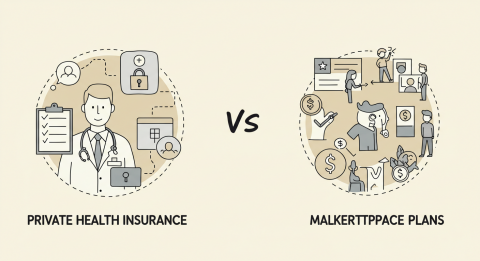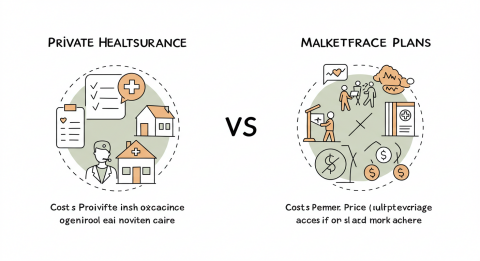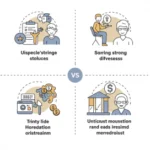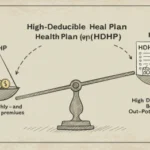Choosing the right health insurance coverage has become increasingly complex as healthcare costs continue to rise and insurance options multiply. In 2025, consumers face a fundamental decision between private health insurance plans purchased directly from insurers and marketplace plans available through government exchanges. Understanding the differences between these options, their respective advantages and disadvantages, and how they align with your specific needs is crucial for making an informed decision.
The landscape of health insurance has evolved significantly since the Affordable Care Act established health insurance marketplaces. Today’s consumers have more choices than ever, but with those choices comes the responsibility of understanding which type of coverage provides the best value, coverage, and peace of mind for their unique circumstances.
This comprehensive guide will help you navigate the key differences between private health insurance and marketplace plans, examine the factors that should influence your decision, and determine which option might be better for your situation in 2025.

Understanding Private Health Insurance
Private health insurance refers to coverage purchased directly from insurance companies without going through government marketplaces or exchanges. These plans are sold by insurers like Blue Cross Blue Shield, Aetna, Cigna, UnitedHealthcare, and many others through their websites, insurance agents, or brokers.
Private plans operate independently of the Affordable Care Act marketplace system, though they must still comply with federal health insurance regulations. This means they provide essential health benefits, cannot deny coverage based on pre-existing conditions, and must follow other consumer protection rules established by healthcare reform legislation.
One significant characteristic of private health insurance is the underwriting process. While insurers cannot deny coverage based on health status, they may conduct medical underwriting to determine pricing and coverage details. This process can be more streamlined than marketplace enrollment, especially for healthy individuals.
Private insurers often offer a broader range of plan designs and options compared to marketplace offerings. They may provide innovative benefit structures, additional wellness programs, or specialized coverage options that cater to specific demographics or health needs.
The application and enrollment process for private insurance typically allows for year-round enrollment, unlike marketplace plans which generally restrict enrollment to specific periods. This flexibility can be valuable for people experiencing life changes or those who miss marketplace enrollment deadlines.
Understanding Marketplace Plans
Marketplace plans, also known as exchange plans, are health insurance policies sold through government-operated exchanges established by the Affordable Care Act. These plans are available through Healthcare.gov for most states, or through state-run exchanges in states that chose to operate their own marketplaces.
All marketplace plans must meet specific standards and provide essential health benefits including ambulatory patient services, emergency services, hospitalization, maternity and newborn care, mental health and substance abuse services, prescription drugs, rehabilitative services, laboratory services, preventive care, and pediatric services.
Marketplace plans are categorized into metal tiers: Bronze, Silver, Gold, and Platinum, plus Catastrophic plans for certain eligible individuals. These tiers indicate the percentage of healthcare costs the plan covers on average, with Bronze plans covering about 60% and Platinum plans covering about 90% of costs.
One of the most significant advantages of marketplace plans is the availability of premium tax credits and cost-sharing reductions for eligible individuals and families. These subsidies can dramatically reduce the cost of health insurance for people with moderate incomes, making coverage more affordable than would otherwise be possible.
Marketplace enrollment is typically limited to annual open enrollment periods, usually occurring from November to January each year. Special enrollment periods are available for qualifying life events such as marriage, divorce, birth of a child, or loss of other coverage.
Cost Comparisons and Financial Considerations
The cost difference between private and marketplace plans can vary significantly depending on your income, age, location, and health status. Understanding how costs compare requires looking beyond just monthly premiums to include deductibles, copayments, coinsurance, and out-of-pocket maximums.
For individuals and families who qualify for marketplace subsidies, exchange plans often provide substantially lower net costs than private insurance. Premium tax credits can reduce monthly premiums, while cost-sharing reductions can lower deductibles, copayments, and coinsurance for Silver-tier plans.
Subsidy eligibility depends on household income relative to the federal poverty level. In 2025, premium tax credits are available for individuals earning up to 400% of the federal poverty level, with enhanced subsidies available for those earning up to 150% of the poverty level through recent legislative changes.
Private insurance premiums may be higher for the same level of coverage, particularly for older adults or those with health conditions, since these plans don’t benefit from the risk pooling and subsidy structure of marketplace plans. However, healthy young adults might find competitive pricing in the private market.
When comparing costs, consider the total annual expense including premiums, deductibles, and expected out-of-pocket costs based on your anticipated healthcare usage. A plan with lower premiums but higher deductibles might cost more overall if you require significant medical care.
Private plans may offer more transparent pricing and simplified cost structures, while marketplace plans can have complex subsidy calculations that change based on income fluctuations throughout the year.
Coverage and Network Differences
Network size and provider access represent crucial differences between private and marketplace plans. Private insurers often maintain broader networks of healthcare providers, specialists, and hospitals, giving you more choices for medical care.
Many private plans offer access to premium hospital systems and specialists who may not participate in marketplace plan networks. This can be particularly important if you have established relationships with specific doctors or require specialized care from particular medical centers.
Marketplace plans sometimes have narrower networks designed to control costs, though this varies significantly by insurer and region. Some marketplace plans offer the same networks as their private counterparts from the same insurance company, while others may have more restricted provider panels.
Prescription drug coverage can also differ between private and marketplace plans. While all marketplace plans must include prescription coverage, the specific drugs covered and the tier structure may vary. Private plans might offer more generous drug coverage or include medications that marketplace plans exclude.
Specialty care access, including mental health services, can vary between plan types. While both must cover essential health benefits, the ease of accessing specialists, the number of covered therapy sessions, or the process for obtaining referrals might differ.
International coverage is another area where private plans sometimes excel, offering better coverage for emergency care while traveling abroad or additional services that frequent travelers value.
Enrollment Flexibility and Timing
Enrollment timing and flexibility represent significant practical differences between private and marketplace plans. Understanding these differences can be crucial if your life circumstances change or if you need coverage outside standard enrollment periods.
Private health insurance typically allows year-round enrollment, giving you the flexibility to purchase coverage whenever you need it. This can be valuable if you experience job loss, age out of a parent’s plan, or have other life changes that affect your insurance needs.
Marketplace plans generally restrict enrollment to annual open enrollment periods, typically running from November 1 through January 15 for coverage beginning the following year. Missing this window means waiting until the next year unless you qualify for a special enrollment period.
Special enrollment periods for marketplace plans are triggered by specific qualifying life events such as marriage, divorce, birth or adoption of a child, loss of other coverage, or moving to a new area. These periods typically last 60 days from the qualifying event.
The enrollment process itself can differ significantly. Private insurance applications may be more straightforward and faster, while marketplace enrollment involves income verification and subsidy calculations that can complicate the process.
For people who value flexibility and want the option to change coverage outside traditional enrollment periods, private insurance offers clear advantages. However, those who prefer structured enrollment periods and don’t anticipate needing to change coverage mid-year may find marketplace timing adequate.
Who Benefits More from Private Insurance
Certain groups of people tend to benefit more from private health insurance based on their circumstances, preferences, and financial situations.
High-income individuals and families who don’t qualify for marketplace subsidies often find private insurance more attractive. Without subsidies to offset costs, marketplace plans offer no price advantage and may provide fewer options or benefits than private alternatives.
People with complex medical needs who require access to specific specialists or medical centers may prefer private insurance for its typically broader networks. If you have established relationships with doctors who don’t participate in marketplace networks, private coverage might be necessary to maintain continuity of care.
Individuals who value flexibility in enrollment timing and plan changes throughout the year benefit from private insurance’s year-round availability. This includes people with variable employment, those who frequently relocate, or anyone who prefers not to be locked into annual enrollment cycles.
Young, healthy adults who rarely use medical services might find private insurance cost-effective, especially if they can secure competitive rates based on their health status and age. Some private insurers offer innovative plan designs that appeal to this demographic.
Business owners and self-employed individuals sometimes prefer private insurance for its flexibility and potential tax advantages. They may be able to deduct premiums as business expenses and appreciate the ability to change coverage as their business needs evolve.
People who frequently travel internationally or need coverage that extends beyond standard domestic networks may find private plans offer better options for their lifestyle needs.
Who Benefits More from Marketplace Plans
Marketplace plans provide significant advantages for specific populations, particularly those who qualify for financial assistance or prefer standardized coverage options.
Individuals and families with moderate incomes who qualify for premium tax credits and cost-sharing reductions can save substantial amounts through marketplace plans. These subsidies can make comprehensive health insurance affordable for people who would otherwise struggle to purchase coverage.
People with pre-existing conditions benefit from marketplace plans’ standardized essential health benefits and consumer protections. While private plans must also provide these protections, marketplace plans offer additional oversight and standardization that some consumers find reassuring.
Families with children benefit from robust pediatric coverage requirements in marketplace plans, including dental and vision coverage that may not be as comprehensive in private alternatives.
Individuals who prefer structured, standardized plan options may find marketplace metal tiers easier to understand and compare than the varied offerings in the private market. The standardized actuarial values make it easier to predict costs and coverage levels.
People who value the consumer protection and advocacy resources available through marketplace enrollment may prefer exchange plans. State insurance commissioners and marketplace officials provide additional oversight and assistance that private plan purchasers may not access as easily.
Lower-income individuals, particularly those near Medicaid eligibility thresholds, benefit from marketplace plans’ coordination with Medicaid programs and the availability of cost-sharing reductions that dramatically lower out-of-pocket expenses.
Regional Variations and Market Dynamics
The relative advantages of private versus marketplace plans vary significantly by geographic region, creating important considerations for your decision-making process.
Some states have robust marketplace competition with multiple insurers offering diverse plan options, while others have limited marketplace participation resulting in fewer choices and potentially higher prices. In areas with limited marketplace competition, private insurance might offer more options.
Urban areas typically have more choices in both private and marketplace plans, while rural regions may have limited options in both markets. Provider networks can be particularly constrained in rural areas, making network adequacy a crucial consideration regardless of plan type.
State regulations and insurance market dynamics affect both private and marketplace plans differently. Some states have additional consumer protections or benefits requirements that apply to all plans, while others maintain more flexibility for private insurers.
Premium pricing varies significantly by region due to local healthcare costs, competition levels, and regulatory environments. What constitutes a good deal in one state may be expensive in another, making local market research essential.
Some regions have seen marketplace plan premiums stabilize or decrease in recent years due to increased competition and federal policy changes, while others continue to experience significant year-over-year increases.
Making the Right Choice for Your Situation
Determining whether private insurance or marketplace plans work better for your specific situation requires careful evaluation of multiple factors and honest assessment of your priorities and circumstances.
Start by calculating your potential costs under both options, including all premiums, deductibles, copayments, and expected out-of-pocket expenses. Don’t forget to factor in any subsidies you might qualify for through marketplace plans, as these can dramatically affect the total cost comparison.
Evaluate your healthcare needs and preferences, including any established relationships with specific doctors or hospitals. If maintaining access to particular providers is crucial, verify their participation in networks before making your decision.
Consider your income stability and predictability. If your income fluctuates significantly throughout the year, marketplace subsidy calculations might become complex, while private insurance offers more predictable pricing.
Think about your need for enrollment flexibility. If you anticipate life changes that might require adjusting your coverage, private insurance’s year-round enrollment could be valuable.
Assess your comfort level with different levels of standardization and regulation. Some people prefer the standardized approach of marketplace plans, while others value the variety and innovation possible in private insurance.

Conclusion and Recommendations
The choice between private health insurance and marketplace plans in 2025 depends heavily on your individual circumstances, financial situation, and healthcare needs. Neither option is universally superior, and the best choice varies significantly from person to person.
Marketplace plans offer compelling advantages for people who qualify for subsidies, prefer standardized coverage options, or want additional consumer protections. The financial assistance available through exchanges can make comprehensive coverage affordable for moderate-income families who would otherwise struggle with health insurance costs.
Private insurance excels for high-income individuals who don’t qualify for subsidies, people who need broader provider networks, or those who value enrollment flexibility and innovative plan designs. The ability to enroll year-round and potentially access premium networks makes private coverage attractive for certain populations.
Before making your decision, thoroughly research your local market options, calculate total costs under different scenarios, and honestly assess your healthcare needs and preferences. Consider consulting with a licensed insurance agent or broker who can help you navigate the options and understand how different plans would work for your specific situation.
Remember that health insurance decisions aren’t permanent. Most people have opportunities to change their coverage annually, so if your chosen option doesn’t meet your needs, you can typically make adjustments during the next enrollment period. The key is making an informed decision based on your current circumstances while keeping in mind how your needs might evolve over time.

Hi, I’m Hibiki — the writer behind HealthManual.net.
I cover health insurance news, wellness tips, and insightful analysis of pharmaceutical and healthcare stocks. My goal is to simplify complex topics and make health and finance information more accessible to everyone.
Thanks for reading — I hope you find the content helpful and reliable.















